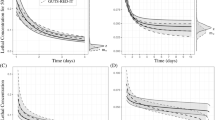Abstract
There is an ongoing discussion whether in the environmental risk assessment for chemicals the so called ‘deterministic’ approach using point estimates of exposure and effect concentrations is still appropriate. Instead, the more detailed and scientifically sounder probabilistic methods that have been developed over the last years are widely recommended. Here, we present the results of a probabilistic effect assessment for the aquatic environment performed for the pesticide methyl parathion and compare them with the results obtained with the common deterministic approach as described in the EU Technical Guidance Document. Methyl parathion was chosen because a sufficient data set (acute toxicity data for about 70 species) was available. The assumptions underlying the probabilistic effect assessment are discussed in the light of the results obtained for methyl parathion. Two important assumptions made by many studies are: (i) a sufficient number of ecologically relevant toxicity data is available, (ii) the toxicity data follow a certain distribution such as log-normal. Considering the scarcity of data for many industrial chemicals, we conclude that these assumptions would not be fulfilled in many cases if the probabilistic assessment was applied to the majority of industrial chemicals. Therefore, despite the well-known limitations of the deterministic approach, it should not be replaced by probabilistic methods unless the assumptions of these methods are carefully checked in each individual case, which would significantly increase the effort for the assessment procedure.
Similar content being viewed by others
References
Aldenberg T, Slob W (1993): Confidence Limits for Hazardous Concentrations Based on Logistically Distributed NOEC Data. Ecotox Environ Safety25, 4–63
Chapman PM, Caldwell RS, Chapman PF (1996): A Warning: NOECs are Inappropriate for Regulatory Use. Environ Toxicol Chem15, 77–79
Chapman PM, Fairbrother A, Brown D (1998): A Critical Evaluation of Safety (Uncertainty) Factors for Ecological Risk Assessment. Environ Toxicol Chem17, 99–108
CFR (1995): Code of Federal Regulations, Title 40, Part 132: Water Quality Guidance for the Great Lakes System. United States Government Printing Office
Duke DL, Taggart M (2000): Uncertainty Factors in Screening Ecological Risk Assessments. Environ Toxicol Chem19, 1668–1680
EEA (1998): Chemicals in the European Environment: Low Doses, High Stakes? European Environment Agency, Copenhagen
Emans HJB, v. d. Plassche EJ, Canton JH, Okkerman PC, Sparenburg PM (1993): Validation of some Extrapolation Methods Used for Effect Assessment. Environ Toxicol Chem12, 2139–2154
EU (1996): Technical Guidance Document in Support of Commission Directive 93/67/EEC on Risk Assessment for New Notified Substances and Commission Regulation (EC) 1488/94 on Risk Assessment for Existing Substances. Office for Official Publications of the European Communities
Forbes TL, Forbes VE (1993): A Critique of the Use of Distribution-Based Extrapolation Models in Ecotoxicology. Functional Ecology7, 249–254
Hammers-Wirtz M, Ratte HT (2000): Offspring Fitness in Daphnia: Is the Daphnia Reproduction Test Appropriate for Extrapolating Effects on the Population Level? Environ Toxicol Chem19, 1856–1866
Hertel R (1993): Environmental Health Criteria 145: Methyl parathion. World Health Organization
Klepper O, Bakker J, Traast TP, Van de Meent D (1998): Mapping the Potentially Affected Fraction of Species (PAF) as a Basis for Comparison Ecotoxicological Risks between Substances and Regions. J Hazard Mat61, 337–344
Kooijman SALM (1987): A Safety Factor for LC50 Values Allowing for Differences in Sensitivity among Species. Wat Res21, 269–276
Koller G, Hungerbühler K, Fent K (2000): Data Ranges in Aquatic Toxicity of Chemicals. ESPR — Environ Sci & Pollut Res7, 135–143
Länge R, Hutchinson TH, Scholz N, Solbé J (1998): Analysis of the ECETOC Aquatic Toxicity (EAT) Database II: Comparison of Acute to Chronic Ratios for Various Aquatic Organisms and Chemical Substances. Chemosphere36, 115–127
Legierse K C H M (1998): Differences in Sensitivity of Aquatic Organisms to Organophosphorus pesticides, Ph.D. Dissertation, University of Utrecht, The Netherlands Newman MC, Ownby DR, Mézin LCA, Powell DC, Christensen
TRL, Lerberg SB, Anderson B-A (2000): Applying Species-Sensitivity Distributions in Ecological Risk Assessment: Assumptions of Distribution Type and Sufficient Numbers of Species. Environ Toxicol Chem19, 508–515
Power M, McCarthy LS (1997): Fallacies in Ecological Risk Assessment Practices. Environ Sci Technol31, 370A-375A
Solomon KR et al. (1996): Ecological Risk Assessment of Atrazine in North American Surface Waters. Environ Toxicol Chem15, 31–76
Solomon KR (1996): Overview of Recent Developments in Ecotoxicological Risk Assessment. Risk Anal15, 627–633
Solomon KR, Giddings JM, Maund SJ (2001): Probabilistic Risk Assessment of Cotton Pyrethroids: I. Distributional Analysis of Laboratory Aquatic Toxicity Data. Environ Toxicol Chem20, 652–659
Steinbach D (1999): Diploma thesis. ETH Zürich
Suter GW (1993): Ecological Risk Assessment. Lewis Publishers, Chelsea, MI, USA
Suter GW (1998): Comments on the Interpretation of Distributions in ‘Overview of Recent Developments in Ecological Risk Assessment’. Risk Anal18, 3–4
Van der Hoeven N (2001): Estimating the 5-Percentile of the Species Sensitivity Distributions without any Assumptions about the Distribution. Ecotoxicology10, 25–34
Van Straalen NM, Denneman CAJ (1989): Ecotoxicological Evaluation of Soil Quality Criteria. Ecotox Environ Safety18, 241–251
Wagner C, Løkke H (1991): Estimation of Ecotoxicological Protection Levels from NOEC Toxicity Data. Wat Res25, 1237–1242
Author information
Authors and Affiliations
Corresponding author
Rights and permissions
About this article
Cite this article
Scheringer, M., Steinbach, D., Escher, B. et al. Probabilistic approaches in the effect assessment of toxic chemicals. Environ Sci & Pollut Res 9, 307–314 (2002). https://doi.org/10.1007/BF02987572
Received:
Accepted:
Issue Date:
DOI: https://doi.org/10.1007/BF02987572




